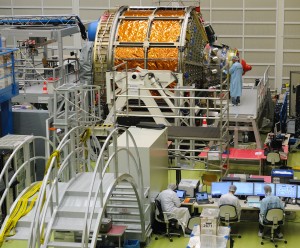First, a summary of today’s successful System Validation Test (SVT), as provided by ESA’s Marcus De Deus Silva, the engineer at ATV-CC responsible for coordinating the test (read our earlier intro post, “Ground-to-space-to-ground: Live connection test for ATV-5 today,” below).
The ATV-5 SVT-1 has just been successfully completed. I would like to thank everyone involved for contributing to this successful and smooth-running test! Also of note is that this is the final ATV SVT to be carried out from Bremen.
– Marcus
The test achievements include:
- The test was successfully run in parallel with ongoing operations of the ATV-4 mission in flight
- We confirmed reception and processing at ATV-CC of telemetry (up to 64 kbps) from ATV-5 through both TDRS channels
- Confirmed telemetry at 8 kbps via ESA’s Artemis relay satellite
- Confirmed the sending of telecommands to ATV-5 via both NASA TDRS and ESA Artemis
- Successful testing of the ATV-5 safety communication links including the sending of ‘Red Button’ Collision Avoidance Manoeuvre (CAM) telecommands from ATV-CC
Earlier, I spoke with Marcus, who answered questions on how the SVT was set up, how it was executed and why it’s important.
OK, first, what’s an SVT?
This will be the first ATV-5 System Validation Test; simply put, an SVT is when the actual spacecraft is connected to the actual mission control system, and for the first time, the engineers at ATV-CC get to send telecommands to the spacecraft, monitoring the responses and overall telemetry from ATV and making sure the craft is functioning as it should.
While it’s a standard test (all ATVs have undergone SVTs), it’s an especially complex one as it involves connecting the ATV, sitting on its integration test bed at Astrium Bremen, with ATV-CC via the satellites that will handle its communications once in orbit: NASA’s TDRS data relay satellites (a fleet of seven) and ESA’s Artemis relay satellite. It’s the final major activity before ATV is shipped from Bremen to Kourou; we’re keen to get it done as preparation and packing for shipping ATV-5 will begin at the end of this week.
What gets tested?
The SVTs include a standard set of tests to ensure that the links up to and down from ATV work as expected; we confirm the link budgets and send test commands, among other important steps. Perhaps most importantly, we also send an actual ‘Red Button’ Collision Avoidance Manoeuvre (CAM) command to ensure that this fundamental critical feature of ATV works as designed.
The test is scheduled on 3 September for two shifts (06:00 to 22:00 CEST) and we have a back-up time slot for the 4th; about 22 hours of test time in total. [Editor’s note: In any event, all went well on 3.09 and the backup slot wasn’t needed.]
The ATV design is mature and very stable and our industrial partners are expert – this is after all the fifth ATV they’ve built, so we don’t foresee any problems. The main challenge is in scheduling the test between Bremen, NASA and ATV-CC while we simultaneously maintain real-time operational contact with ATV-4, which is now in orbit docked to the ISS. This is pretty complex!
Also, we want to avoid, for example, any chance that we might send a test command to the orbiting ATV or a real command to the non-orbiting ATV. Therefore, we have to have a way to completely isolate the two (separate) control ‘chains’. It’s a lot of work to separate the two sets of procedures, but that’s all part of the preparations that ensure the actual test goes smoothly.
How do you do that?
Basically, we use the Earth! We schedule the sending and receipt of signals to/from ATV-5 at Bremen via NASA’s TDRS satellites and ESA’s Artemis when the ISS is below the horizon and out of contact with Artemis or the specific TDRS satellite booked for the test (it was TDRS No. 6 – Ed.).
Who’s involved?
It’s a big list! We have to coordinate with ATV-CC, Bremen, ESA’s Columbus CC, DLR, ESA Redu (from where Artemis is controlled) and NASA Houston and Goddard; each of these have their own limitations and constraints on availability and functioning, so that all has to be coordinated. There’s no ISS or crew involvement.
For TDRS, the telecommands sent by the mission controllers at ATV-CC will travel to ATV as follows:
- Console workstation at ATV-CC–>
- IGS Network (ESA/NASA interface)–>
- NASA Houston–>
- White Sands TDRS ground station–>
- Up to TDRS in geostationary orbit–>
- Down to the rooftop antenna on the ATV integration building at Astrium/Bremen–>
- Via cable to the ‘air horn’ radio-frequency interface sitting beside ATV–>
- Across a few centimetres of air into the receiving antenna on ATV –>
- Into the ATV computers
What do Artemis and TDRS have to do to support this?
The two satellites have to conduct some special pointings to transmit/receive signals to/from Bremen; Astrium have roof-top dish antennas on top of the ATV integration building at Bremen, and that’s how they grab the telecommands off of the satellites to feed them down into ATV-5. These pointings have to be tested in the week prior to the SVT.
What does the test look like from the ATV-5 standpoint?
The on-board systems simply ‘see’ a radio signal received in from the ATV’s external antennas; the vessel has no idea it’s not in space! 🙂


 Automated Transfer Vehicle page
Automated Transfer Vehicle page ATV blog archive
ATV blog archive
Discussion: no comments